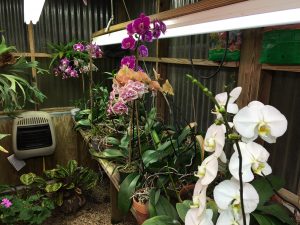Raising orchids is one of Bob Kunst’s passions. The president of Fischer Environmental Services in Mandeville, La., (and the subject of Pest Management Professional‘s August 2016 After Hours column), got hooked after buying them for his wife, Barbara, because she loved them so.
After inadvertently killing his store-bought plants, Kunst learned how to care for them properly by reading about them and talking to others who shared his love of orchids.

Bob Kunst built a greenhouse for the orchids he raises.
Kunst, who built a greenhouse for his orchids while rebuilding after Hurricane Katrina destroyed everything in its path, says orchids are not like typical plants.
“When I first started, most of the time I killed orchids because I paid too much attention to them,” he says. “Don’t pay too much attention to them, other than to look at them.”
After more than 10 years of caring for orchids, Kunst shares seven tips.
- Start with orchids that are the easiest to grow. With 25,000 to 30,000 species of orchids, choose wisely. Kunst recommends the Phalaenopsis (moth orchid) or Cymbidium (boat orchid) varieties because they are easy to grow and require very little care. Brassia, the species known as spider orchids, are widely available at stores, but Kunst advises to steer clear. “I wouldn’t buy those unless I had a facility like I do because they are real sensitive,” he says. “You buy them and they look nice, and then they die on you.”
- Orchids tell you what they need. If the leaves turn light to dark green, it’s getting too much light. If the leaves become very dark green, it’s not getting enough light. “It’s the opposite of anything you would think,” Kunst says. “You have to read them that way.”
- Orchids don’t like to be moved. When you buy an orchid, find the ideal place for it in your home, and leave it there. For instance, don’t put it in the dining room and then relocate it to the living room because you think it might look better there instead. “If it would have, you should have set it there to begin with,” he says.
- Orchids shouldn’t stay wet. A couple of times a week in the summer or once a week in the winter, give the orchid a good dousing of water. Because orchids are not grown in dirt (wood bark or sphagnum moss typically is used), watering generously once or twice a week will make their roots, which look white, turn green. That’s because orchids take in oxygen through their roots, Kunst says. Let the water drain thoroughly. Consider keeping orchids in clay pots, because clay dries fast.
- Ventilation is good for orchids. Keeping the air moving near an orchid is beneficial for many reasons. It helps keep the plant dry after watering (wet leaves invite mold); it facilitates the plant’s ability to produce nutrients; and it helps the plant tolerate warmer temperatures. “Keep ventilation going all the time, because orchids are used to being outside where the air moves back and forth,” says Kunst, who uses fans to keep the air moving in his greenhouse.
- Add fertilizer several times a year. Orchids do not need as much fertilizer as many other plants, but they do need some. Many orchid aficionados recommend applying a watered-down dose of fertilizer once a week. Opt for fertilizers made especially for orchids because they are free of urea. Kunst says the easiest way for a novice to add the nutrients orchids need to thrive is by using fertilizer stakes that can be shoved into the pot and ignored.
- Control insects with a home remedy. Orchids may be susceptible to insect infestations, such as whiteflies. Kunst says he hasn’t found any insecticides labeled for use on orchids, so he uses a light coating of oil to suffocate the pests. “It seems to work very well,” he says.
Now that orchids are widely available at many stores for low prices, there’s no reason not to enjoy their beautiful blooms at home.
“Buy an orchid, put it in your house, let it get comfortable, and read a little bit about it,” Kunst says. “Then you’ve got something that’s an item of beauty.”
Leave A Comment